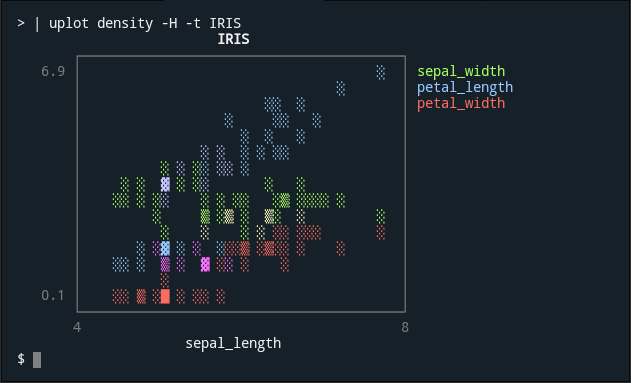
 YouPlot is a command line tool that draws plots on the terminal.
:bar_chart: Powered by [UnicodePlot](https://github.com/red-data-tools/unicode_plot.rb)
YouPlot is a command line tool that draws plots on the terminal.
:bar_chart: Powered by [UnicodePlot](https://github.com/red-data-tools/unicode_plot.rb)
Installation
gem install youplot
Quick Start





uplot <command> [options] <data.tsv>
barplot
curl -sL https://git.io/ISLANDScsv \
| sort -nk2 -t, \
| tail -n15 \
| uplot bar -d, -t "Areas of the World's Major Landmasses"

histogram
echo -e "from numpy import random;" \
"n = random.randn(10000);" \
"print('\\\n'.join(str(i) for i in n))" \
| python \
| uplot hist --nbins 20

lineplot
curl -sL https://git.io/AirPassengers \
| cut -f2,3 -d, \
| uplot line -d, -w 50 -h 15 -t AirPassengers --xlim 1950,1960 --ylim 0,600

scatter
curl -sL https://git.io/IRIStsv \
| cut -f1-4 \
| uplot scatter -H -t IRIS

density
curl -sL https://git.io/IRIStsv \
| cut -f1-4 \
| uplot density -H -t IRIS

boxplot
curl -sL https://git.io/IRIStsv \
| cut -f1-4 \
| uplot boxplot -H -t IRIS

count
cat gencode.v35.annotation.gff3 \
| grep -v '#' | grep 'gene' | cut -f1 \
| uplot count -t "The number of human gene annotations per chromosome" -c blue

In this example, YouPlot counts the number of chromosomes where genes are located.
Note: count is not very fast because it runs in a Ruby script.
This is fine in most cases, as long as the data size is small. If you want to visualize huge data, it is faster to use a combination of common Unix commands as shown below.
cat gencode.v35.annotation.gff3 | grep -v '#' | grep 'gene' | cut -f1 \
| sort | uniq -c | sort -nrk1 \
| uplot bar --fmt yx -d ' ' -t "The number of human gene annotations per chromosome" -c blue
Usage
Commands
uplot is the shortened form of youplot. You can use either.
| Command | Description |
|---|---|
| `cat data.tsv \ | uplot |
uplot <command> [options] data.tsv ... |
Take input from files |
| `pipeline1 \ | uplot |
Subcommands
The following sub-commands are available.
| command | short | how it works |
|---|---|---|
| barplot | bar | draw a horizontal barplot |
| histogram | hist | draw a horizontal histogram |
| lineplot | line | draw a line chart |
| lineplots | lines | draw a line chart with multiple series |
| scatter | s | draw a scatter plot |
| density | d | draw a density plot |
| boxplot | box | draw a horizontal boxplot |
| count | c | draw a barplot based on the number of occurrences (slow) |
| colors | color | show the list of available colors |
Output the plot
-o- By default, the plot is output to standard error output.
- If you want to output to standard input, Use hyphen
-o -or no argumentuplot s -o |.
Output the input data
-O- By default, the input data is not shown anywhere.
- If you want to pass the input data directly to the standard output, Use hyphen
-O -or no argumentuplot s -O |. - This is useful when passing data to a subsequent pipeline.
Header
-H- If input data contains a header line, you need to specify the
-Hoption.
- If input data contains a header line, you need to specify the
Delimiter
-d- You do not need to use
-doption for tab-delimited text since the default value is tab. - To specify a blank space, you can use
uplot bar -d ' ' data.txt.
- You do not need to use
Real-time data
-p--progress- Experimental progressive mode is currently under development.
ruby -e 'loop{puts rand(100)}' | uplot line --progress
Show detailed options for subcommands
--help- The
--helpoption will show more detailed options for each subcommand. uplot hist --help
- The
Set columns as x-axis or y-axis
- YouPlot treats the first column as the X axis and the second column as the Y axis. When working with multiple series, the first column is the X axis, the second column is series Y1, the third column is series Y2, and so on.
If you pass only one column of data for
lineandbar, YouPlot will automatically use a sequential number starting from 1 as the X-axis.--fmt--fmt xyy--fmt xyxy--fmt yxoptions give you a few more choices. Seeyouplot <command> --helpfor more details.- The fmt option may be renamed in the future.
- The
-xand-yoptions might be used to specify columns in the future.
Use
awk '{print $2, $1}'to swap columns. Usepasteto concatenate series.
Categorical data
- With GNU datamash, you can manage to handle categorized data.
cat test/fixtures/iris.csv | sed '/^$/d' | datamash --header-in --output-delimiter=: -t, -g5 collapse 3,4 | cut -f2-3 -d: | sed 's/:/\n/g' | uplot s -d, -T --fmt xyxy- This is not so easy...
Time series
- Not yet supported.
YouPlot Configuration (youplotrc)
You can specify default options in a configuration file in YAML format. For more information, enter the following command.
uplot --config
Tools that are useful to use with YouPlot
Contributing
YouPlot is a library under development, so even small improvements like typofix are welcome! Please feel free to send us your pull requests.
- Report bugs
- Fix bugs and submit pull requests
- Write, clarify, or fix documentation
- English corrections by native speakers are welcome.
- Suggest or add new features
- Make a donation
Development
# fork the main repository by clicking the Fork button.
git clone https://github.com/your_name/YouPlot
bundle install # Install the gem dependencies
bundle exec rake test # Run the test
bundle exec rake install # Installation from source code
bundle exec exe/uplot # Run youplot (Try out the edited code)
Do you need commit rights to my repository?
Do you want to get admin rights and take over the project?
If so, please feel free to contact us.
Acknowledgements
- sampo grafiikka - Project logo creation
- yutaas - English proofreading